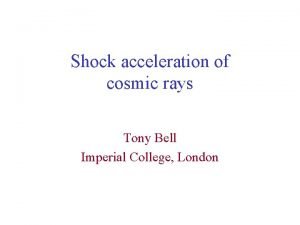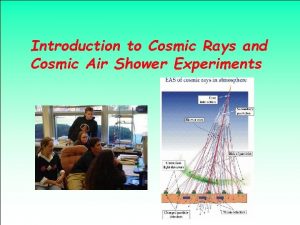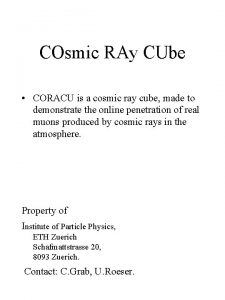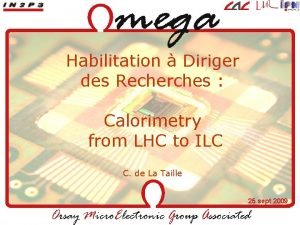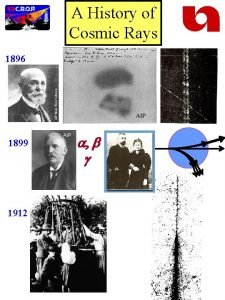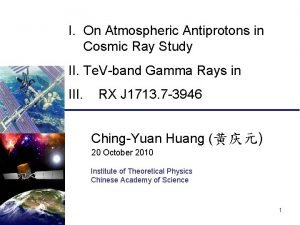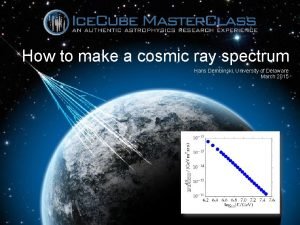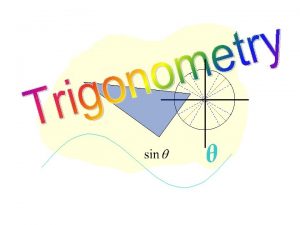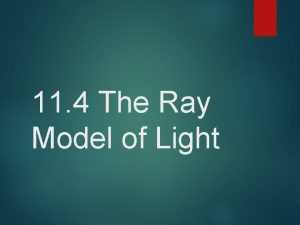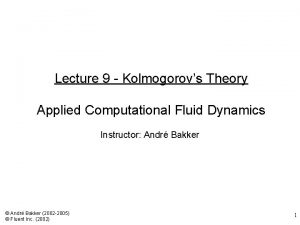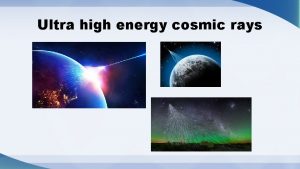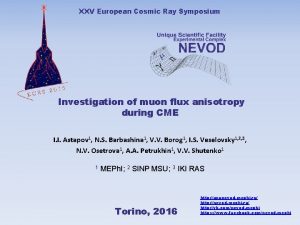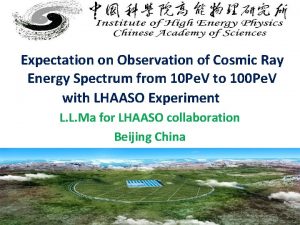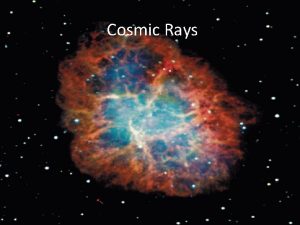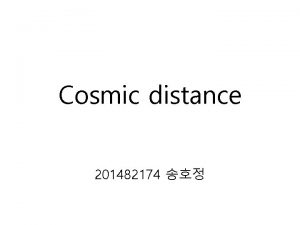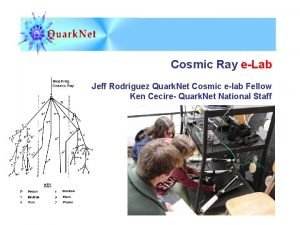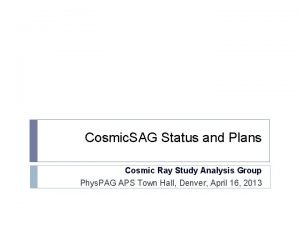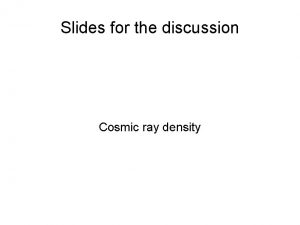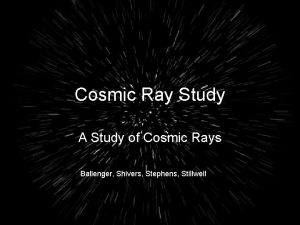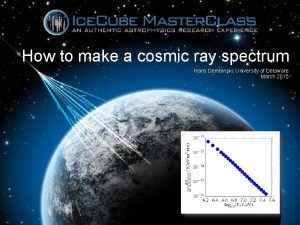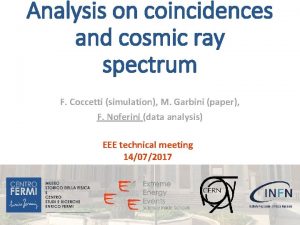25 th European Cosmic Ray Symposium Energy spectrum















- Slides: 15

25 th European Cosmic Ray Symposium Energy spectrum of cascade showers generated by cosmic ray muons in water R. P. Kokoulin, N. S. Barbashina, A. G. Bogdanov, V. D. Burtsev, D. V. Chernov, S. S. Khokhlov, V. A. Khomyakov, V. V. Kindin, K. G. Kompaniets, A. A. Petrukhin, V. V. Shutenko, I. I. Yashin National Research Nuclear University MEPh. I (Moscow Engineering Physics Institute), Russia 5 – 9 September 2016, Torino

Introduction • Cherenkov water detectors (CWD) are widely used for investigating the ultrahigh-energy muons and neutrinos (Ice. Cube, ANTARES, Baikal); • The energy of these particles is estimated through cascade showers. • Investigation of distribution of the Cherenkov light from cascade showers in water is a topical experimental task. Its solution allows to verify the models of cascade particles scattering, make progress in the recognition of showers and reconstruction of their parameters. • Large-scale detectors with long distances between the measuring modules are limited to obtain the detailed picture of light. • In the present work, the light distribution from cascades is studied with the Cherenkov detector having a dense lattice of detecting modules. 2

Cherenkov water detector NEVOD • 2000 m 3 volume; • The detecting system is formed as a spatial lattice of 91 quasi-spherical modules (QSM), arranged in 25 vertical strings (2 x 2. 5 m step). • Each QSM has six PMTs with flat cathodes, directed along the coordinate axes. • The dynamic range for each PMT is 1– 105 ph. e. A small step of the spatial lattice and a wide dynamic range allow the detector to study the distribution of the Cherenkov light from showers with the detalisation of half a meter. 3

Experimental complex NEVOD-DECOR System of calibration telescopes Lattice of quasi-spherical modules (QSMs) of CWD Supermodules of the coordinatetracking detector DECOR 4

Study of cascade showers with axes determined from the coordinate-tracking detector The cascades produced by nearly horizontal muons were investigated (zenith angles are 85º÷ 90º). The tracks were reconstructed by means of coordinate detector DECOR. O. Saavedra at al. , J. Phys. : Conf. Ser. 409 (2013); S. S. Khokhlov et al. , Bull. RAS. Phys. 77 (2013). Selection: 522 events with reconstructed energies from 100 Ge. V to 500 Ge. V 5

Distribution of light from the cascade showers The responses of the QSMs in all events are normalized to reconstructed energy values: where ε 0 is the normalization energy of 200 Ge. V (close to the average energy of showers in the sample); ε is the reconstructed energy of the shower in the event; Ai is the amplitude of i-th PMT in QSM (in photoelectrons, ph. e. ). reconstructed point of the cascade maximum 6

Compensation of light attenuation Since the parameters of the light attenuation are the same for cascades and for single muons, it is reasonable to consider the ratio of light intensity for cascades (B) to the intensity measured for events with single muons (Bμ): θс 7

Influence of scattering of cascade particles The longitudinal profiles of (B-Bμ)/Bμ value at different distances from the axis The profiles become wider with increasing the distance from the axis of the shower. 8

Models of cascade particles scattering 1. Analytical solution of cascade equations (I. P. Ivanenko et al. / Proc. of the 1978 DUMAND Summer Workshop). Cascade electrons angular distribution 2. Approximation (M. G. Aarsten et al. / Nucl. Instr. Meth. in Phys. Res. A 711, 2013) of MC simulation with GEANT 3 (C. H. Wiebusch / Ph. D. Thesis, Physikalische Institute, RWTH Aachen, 1995). Cherenkov radiation angular distribution Calculations with assumption that photons are emitted at the same angle to the track of the electron θc = arrcos(1/n) 9

Comparison of experimental data with calculations In the region of maximum, both models satisfactory agree with experiment. On the rising segment of the profile (responsible for propagation of light to the backward hemisphere of the shower) the model of C. Wiebusch is preferable. 10

Study of cascade showers with unknown axis Showers were selected among the events with a high energy release (not less than 60 QSMs are triggered) on the basis of CWD response only. Such events include: EAS Muon bundles Cascade showers from hadrons and muons The selection of showers is based on the compactness of the cluster of QSMs with the highest responses. The methods were verified on the cascades with known axis. 11

Basic criteria of selection of events with showers 1. Compactness of the group of QSMs with highest responses (the RMS radius of the cluster < 2. 3 m); 2. Development of the shower in the sensitive volume of the detector: limitation of coordinates of the center of gravity of QSMs with highest responses; After iterative reconstruction of characteristics of the shower (location and direction of the axis, energy of the shower and its location – 6 parameters) : 3. Selection of cascades generated mainly by muons (zenith angle of the axis of the shower 55º < θ < 90º). 12

Spectrum of cascade showers, initiated by muons in water (preliminary) Here γ is the slope of the integral energy spectrum of parent pions and kaons. 13

Conclusions • For the first time, the spatial distribution of Cherenkov light from high energy cascade showers generated by muons in water has been experimentally measured at the CWD NEVOD. • The results demonstrate a good directivity of the light from the cascades at the angle close to the angle of Cherenkov radiation in water (≈ 42˚). • The comparison shows the consent of experimental data (based on a sample of ~ 500 cascade events with reconstructed energies 100 -500 Ge. V) with models of scattering of cascade particles. • The method of reconstruction of parameters of showers based on the 3 D model of spatial distribution of the Cherenkov light is developed. It allowed to increase the statistics of showers, and hence to move to higher energies of showers in the energy spectrum measurements. 14

Thank you for your patience! 15
 Cosmic ray spectrum
Cosmic ray spectrum Cosmic ray showers
Cosmic ray showers Cosmic ray elab
Cosmic ray elab Coracu
Coracu Bit flip cosmic ray
Bit flip cosmic ray Cosmic ray
Cosmic ray Cosmic waves
Cosmic waves Cosmic ray
Cosmic ray Orbital diagram for cu
Orbital diagram for cu Absorption spectrum vs emission spectrum
Absorption spectrum vs emission spectrum Initial ray definition
Initial ray definition Ray model of light
Ray model of light Ray casting method in computer graphics
Ray casting method in computer graphics Energy energy transfer and general energy analysis
Energy energy transfer and general energy analysis Energy energy transfer and general energy analysis
Energy energy transfer and general energy analysis Kolmogorov energy spectrum
Kolmogorov energy spectrum
